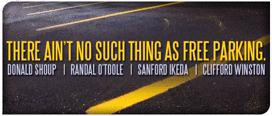Were an alien visitor to hover a few hundred yards above the planet, it could be forgiven for thinking that cars were the dominant life-form, and that human beings were a kind of ambulatory fuel cell, injected when the car wished to move off, and ejected when they were spent.—Heathcote Williams
Sanford Ikeda makes many good points, and in my first response to him I said, “I certainly agree with Sanford Ikeda’s recommendation that neighborhoods should be able to spend their curb parking revenue on their highest priorities.” I did not respond to his six points where he thinks we may disagree, and I regret that he therefore inferred that I “evidently think them not worth addressing.” So let me try to respond to some of his points.
First, I did not say that “zero-price curbside parking is the most disastrous experiment ever in social engineering.” I did say that “Minimum parking requirements may be our most disastrous experiment ever in social engineering.” Minimum parking requirements, not free curb parking, are the social engineering. Free curb parking is a sin of omission—failing to charge the right price for curb parking—while minimum parking requirements are a sin of commission—forcing up the supply of parking at every land use.
Second, Ikeda says, “It’s easy to think of quite a few other social-engineering experiments here that have been at least as bad if not orders of magnitude worse: rent control, The Great Society, nation building, slavery.” I confess that I had not considered slavery and nation building (which needs more explanation) as social engineering. As for rent control, it never extended to more than a small share of the housing stock, and it didn’t last long in most cities that tried it. In contrast, cities have imposed minimum parking requirements for almost all housing in the nation for decades. So I do not agree that rent control is “as bad if not orders of magnitude worse” than minimum parking requirements.
In The High Cost of Free Parking, I estimated that the total subsidy for off-street parking in 2002 was between $127 billion and $374 billion. Because the U.S. gross domestic product was $10.5 trillion in 2002, the subsidy for off-street parking as a share of the economy amounted to between 1.2 percent and 3.6 percent. This subsidy is huge by any comparison. In 2002, the federal government spent $231 billion for Medicare, and $349 billion for national defense.
Can the subsidy for off-street parking be anywhere near that big? Well, why not? Since the 1950s, most American cities have required every new building to provide ample off-street parking. American households now have more cars than drivers, and their cars are parked 95 percent of the time. Because motorists rarely pay anything for parking, their cars live almost rent free. American cars and light trucks logged 2.6 trillion vehicle miles of travel in 2002, so the subsidy for off-street parking ranged between 5¢ a mile (if the subsidy was $127 billion) and 14¢ a mile (if it was $374 billion). If we use the rule of thumb that increasing the gasoline tax by 1¢ a gallon increases gasoline tax revenue by about $1 billion a year, it would take an increase in the gasoline tax of between $1.27 and $3.74 a gallon to offset the subsidy for off-street parking. De-subsidizing off-street parking could thus produce the same effect on travel as increasing the gasoline tax by between $1.27 and $3.74 a gallon. Because parking costs so much and motorists pay so little for it, the hidden subsidy for off-street parking is truly gigantic.
And then there is the subsidy for on-street parking. The U.S. Department of Commerce estimates that the value of roads is 36 percent of the value of all state and local public infrastructure (which also includes schools, sewers, water supply, residential buildings, equipment, hospitals, and parks). Because curb parking occupies a substantial share of road space, it must be a substantial share of all state and local public infrastructure. Drivers do not pay gasoline taxes while their cars are parked, except perhaps on the gasoline lost through evaporative emissions, which pollute the air. Since drivers do pay gasoline taxes while they are driving, curb spaces are subsidized much more than the travel lanes are. Free curb parking may be the most costly subsidy that American cities provide for most of their citizens.
The size of these subsidies for both on-street and off-street parking explain why I said, “Minimum parking requirements may be our most disastrous experiment ever in social engineering, and ceasing to require off-street parking is not social engineering.” I even hedged the statement by using the word may.
Finally, in his first post, Ikeda says I urge that curb parking revenue should “be used for sidewalk and street repair.” In his most recent post he says, “Both Professors Shoup and O’Toole seem to think they know what the ‘free-market solution’ will be: for the former it’s expenditure on sidewalk repair and for the latter it’s more spending on parking.”
I think Sanford Ikeda has misinterpreted my proposal for what to do with curb parking revenue. I never said that the revenue should go for repairing sidewalks or streets. In my first response essay, I said, “I certainly agree with Sanford Ikeda’s recommendation that neighborhoods should be able to spend their curb parking revenue on their highest priorities.”
In my first response, I did not focus on the points where we disagree, and this omission was not because I thought them “not worth addressing.” Instead, I focused on the points where we do agree. After being asked to discuss the points where we disagree, I appreciate the opportunity to make a stronger case for my statement that minimum parking requirements may be our most disastrous experiment ever in social engineering.

